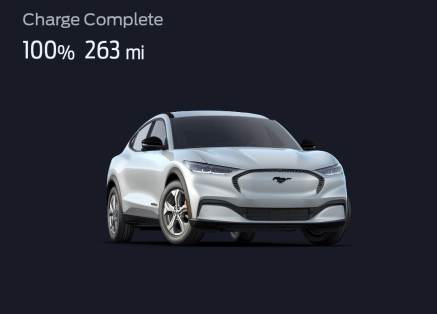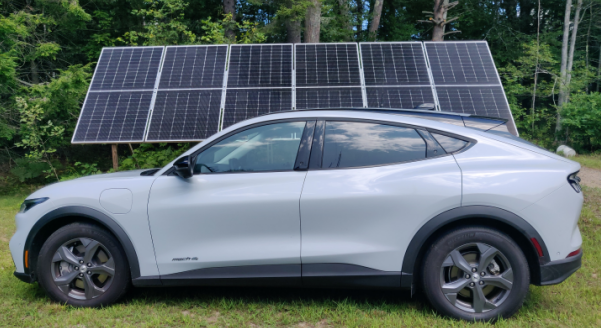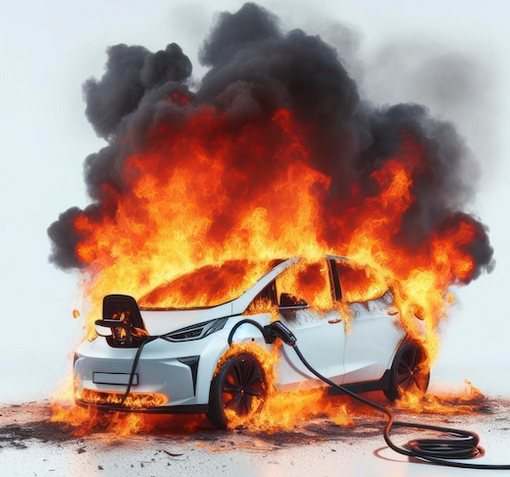Electric Vehicle misc Thoughts

I purchased my 2023 Ford Mustang Mach-E in early March 2024 as a leftover, standard range, AWD. It’s been an amazing adventure going all electric, one I am really enjoying.
Topics include
EV Economics
Environmental Impact
Energy Usage
Range
Charging on the road
Battery longevity
Battery Fires
But my use case is X
The grid will collapse
Summary
I have really enjoyed owning and driving this car. I am not likely to own an internal combustion engine vehicle as my primary transportation any time soon, perhaps never again. It seems clear to me electric is the way to go unless you have a use case that it just doesn’t fit.
About the ‘Facts’ Here.
You should do your own research. My information is from the internet or my observations and can be wrong. If you find something that is just plain wrong I appreciate you letting me know. I will update this blog post.
EV Economics
Driving an EV can reduce your expenses on fuel and maintenance, leading to savings over time. However, purchasing decisions should not be based solely on financial savings. The cost of EVs in the US is now comparable to that of gas-powered cars. For example, my Mach-E Mustang had a sticker price of $42K, which is similar to an equivalent gas-powered car.
Environmental Impact

A gallon of gas in an efficient vehicle can get you 40 miles. The equivalent amount of energy in an EV can get you about 90 miles. I have owned all my previous vehicles beyond 100K miles. 100K would be about 2500 Gallons of gas or about 82,500 KWH of energy in a gas car. In my EV I will get about 3 miles per KWH so I will use 33,333 KWH of electricity. That is about 60% less energy used in my EV.
The mining of elements for making batteries for EV has an impact but considering an EV will use less than half the energy of a gas car through its lifetime I can’t believe its worse than a gas car. We can’t ignore that obtaining oil and burning it has its costs also.
My EV has a LFP battery. Lower energy density than other technologies but easier to get the elements to make it. Easier to recycle. Longer life span.
Then we could talk about where the energy comes from. There are many solar and wind farms out there now producing an increasing amount of our energy needs. I have some solar panels myself but only 3.2KW array. Its estimated to produce 4,250 KWH per year which if used just for driving would be greater than 12K miles.
If you park your EV in a small garage and turn it on what happens? Pretty much nothing at all. Lets imagine doing the same with a gas powered car. The garage will warm up from the waste heat. The garage will likely get smokey. You may also die.
Energy Usage
Once you look into just how much energy your electric car doesn’t use its amazing. Let me give you some points I think really highlight this.
My commute is 44 miles, 88 round trip. A gallon of gas has 33KWH of energy. For the fun of it lets say my last car, a hybrid, got 44 miles per gallon. This means I can drive to the office using 1 gallon of gas. Now lets put the same energy in my electric car, 33KWH. My car is doing about 3.5 miles per KWH for summer driving. That means with the same energy it took to get my gas powered car to the office, 44 miles, I can drive my electric car 115 miles.
A few of my co-workers will often eat lunch in their cars. Its summer time and has been pretty hot so they sit with the AC running. The average 4 CYL car uses about 0.35 gallons per hour when idling, closer to 0.5 with the AC on. Gas has 33KWH per gallon so assuming they sit in the car 30 minutes they will use about 0.25 Gallons of gas. That works out to 8.25 KWH of energy used. So they sit in a hot car while the ~25% efficient engine creates mostly heat, trying to stay cool. The engine block, exhaust system, radiator, etc all radiating waste heat, so they can stay cool.
Now lets talk about one of the ‘bad’ things about an EV. The range drops a lot in the winter time. A large part of the reason for this drop is that there isn’t much waste heat. A gas powered car is about 70% waste heat so if you need some to keep the cabin warm, you’ve got it. Its difficult for me to see this as a negative. I have so much less wasted energy as heat, that if I want heat, I have to make it.
Not sure its easy to ignore just how much more energy efficient an EV is compared to even the best, hybrid, gas powered cars.
Range
My standard range vehicle has an EPA rating of 226 Miles. This summer I’m finding I’m getting 250+. On the coldest days of the winter I suspect I’ll be getting somewhere between 150 and 180. I’ll report back more about that later after I have it through a winter. I’ll use the number 200 as an average moving forward.
How many days a year do you drive more than 200 miles? 200 miles is a long drive. For every day you don’t drive more than 200 miles you only need to charge at home. Every day you get in your vehicle it will be ready to travel another 200 miles. No trip to the gas station required and your energy cost will be significantly less. Since I purchased my car I have charged on the road because of need twice. I have had it nearly 4 months and drove over 7K miles.
When my wife fills her gas powered car her range is closer to 500 miles so this on the surface seems like a big negative for EVs. The funny thing is she will likely spend more time at gas stations than I will at charging stations because every morning I wake up I can drive up to another 200 miles without needing to stop for gas. Its only rare occasions I need to stop and charge on the road.
Charging on the Road

When I purchased my car I told myself and people around me that I just didn’t plan to use it for long trips. My wife drives a beautiful SUV and the plan was I would just swap vehicles with her for the day. One person I told, the owner of a Chevy Bolt EV told me that wasn’t going to happen. He said charging on the road wasn’t a big deal and I would just take my electric car. He was correct.
My Mach-E, and just about any EV are pretty fun to drive. They are quiet, smooth, and accelerate faster than most cars. The technology packages are impressive, and fun. So there is a strong desire to just drive my own car. Turns out that is pretty easy to do.
At first you’re nervous about charging but it goes away. When I first started driving my car I looked for any possible DC rapid chargers and gave them a try. Every trip I took, even close to home, I would pretend I needed to charge. I learned a lot. For example there is one charging location with first generation DC rapid chargers and they are not reliable, often not working. I have found others I categorize as awesome. I found DC rapid chargers in very convenient places such as shopping centers, super markets and highway rest stops.
Of the two times I actually needed to charge on the road, I chose to only charge for 10 minutes. This is because both trips were just to the high side of my range and a 10 minute charge gets me about 50 more miles. I just didn’t need to charge any more.
Don’t dismiss standard L2 chargers. They are everywhere. Getting 30 miles of range per hour of charging is pretty slow but lets say your visiting a small town to spend some time shopping and getting lunch. You will likely spend a couple of hours there. That’s 60 more miles you can drive.
One negative point of note about DC fast charging on the road. You will pay almost three times the price for electricity you will pay when charging at home. Home charging saves money when compared to having a gas powered car. Charging on the road will cost you more. There are many Level2 chargers that are completely free, as long as you have the time to wait.
Any building with electricity is a potential place you can charge. Most cars come with a charger that can work on 120V or 240V. 120V charging plugs are everywhere but you will only gain about 3 Miles for every hour your plugged in. 240V plugs will get you closer to 30 miles per hour of charging but are harder to find. You will find suitable plugs at campgrounds and commonly used for an electric cloths dryer.
Battery Longevity
Many think a degrading battery is a major concern for EV owners. It really isn’t. First the manufacturers take away this concern by offering very generous warranties on the EV battery. Not to mention an LFP (Lithium Iron Phosphate) battery is rated for anywhere from 3000 to 10,000 cycles. A cycle is a full charge and fully discharged. In my car that translates to somewhere between 600K and 2M miles before my battery hits a point where it only has 80% capacity.
Lets say you have the longer range battery, the NCM type. You should worry if you expect to put more than 250K miles on your car, very uncommon.
Battery Fires

National Fire Protection Association (NFPA) and other studies indicate that gasoline vehicles experience significantly more fires compared to EVs. Think about it. They are frequently hot and carrying around a highly flammable liquid. It only makes sense. We are at a time when any EV catching fire is national news, not so much for a gasoline powered car. They have been catching on fire for years.
Many fire departments have expressed concerns about fighting EV fires, and rightfully so. They are trained how to fight gasoline fires. The training and experience with EVs is a work in progress.
Recently a Tesla crashed driving at a high rate of speed in Naples Maine, USA. It hit so hard it scattered individual battery cells over a wide area, the driver was killed instantly. I watched the fire chief being interviewed. There were small pieces of battery burning all over the place. My take away was that a big problem for them was debris collection. How do we handle the scattered pieces of this battery? Where do we put them to insure more fires don’t start? These are real problems but I don’t believe they are unsolvable.
Not all batteries are the same. Chemistries and manufacturer quality are important. There have been products with design flaws such as the Galaxy Note 7, that sparked a lot of fires.
Lithium batteries are now everywhere. I’m sitting in a room that has 4 I can think of quickly. There are 2 laptops, a cell phone, and a portable battery for cell phone charging. They have a great safety record.
For my EV and battery power tools I keep them in my garage. A garage that has thicker sheet rock that was mandated many years ago to protect me from my gas powered car, that is significantly more likely to catch fire than my battery operated things.
But my use case is X
There will be use cases where a gas powered car is a better choice. From what I can tell it takes a lot of energy to plow roads, tow trailers, move cargo long distances, etc. Energy that just isn’t available in an EV with current technology. There are some remote locations, or remote locations with really cold climates. etc..
I think many things can be made to work, if you want them to. For example you own a remote camp you frequently drive to. Take a look, are there charging locations in route? Do you have electricity at your remote camp and can charge while there for your return trip?
Are you on on the road sales person and drive more than 200 miles in a day frequently? Take a look around. Do some of your customers have EV charging? Perhaps a lunch stop charging station. Most cars can charge in less than 30 minutes to 80% capacity, that is pretty quick.
Do you drive 1500 miles to Florida every fall to return in the spring? That can be done in an EV. In my car I would have to charge just under 6 hours total at DC fast chargers. This 6 hours is if I did NOT plan to charge at any hotel I may stay at. So every 2 hours of driving I need to sit at a charger for 30 minutes. Keep in mind this is in my ‘standard range’ 226 EPA rated vehicle. Many EVs can do better. Like I said, it can work if you want it to. If you don’t then you will see this as unacceptable. I hope to do this trip, this year, just to see how it goes. My figures were generated by a trip from Portland, Maine to Orlando, FL using https://abetterrouteplanner.com/ as my trip tool.
The Grid will Collapse
The usual narrative is something like that if everyone swapped over to EVs the grid couldn’t handle it. I guess the premise being everyone switched over at the same time. I agree, if the completely impossible were to happen and we all were driving EVs suddenly the grid would collapse. What is possible, and currently happening, is we are swapping over slowly and in a manner that enables our power supply and delivery companies to keep up.
There may eventually be policies put in place to encourage off peak charging. Newer technologies that allow for the fleet of EVs to give power back to the grid during peak demands, etc. Time will tell how this all works out but the collapsing grid is not a likely outcome.